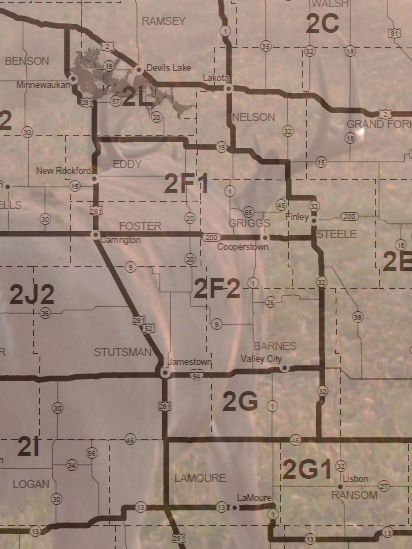
The Lines that Bind Us. The state’s firearms deer hunting units have evolved over decades of management by the North Dakota Game and Fish Department, with each one breaking down a specific biome or broader territory. Image Combination: Simonson/NDG&F.
By Nick Simonson
In North Dakota, the unit in which a sportsman hunts deer is almost analogous to one’s hometown in the grand sense of things, and particularly in November for the state’s firearms deer season.
The response of “4B” or “2F2” to the question of “where’d you draw your tag” conjures up rugged hillsides or rolling prairie farmland respectively, and is almost as easy to identify on a mental map as the blacktop roads that surround the hunting area and the small towns which serve as outposts within it. In a time before the more than three dozen units in the state came to be, however, there weren’t so many options and the landscape was broken down into bigger units – and reserve areas – in relation to the management of the state’s herds decades ago.
“Originally, the state was divided up into much larger management units and they had some units that were set up as refuge areas, that was one of the early strategies for deer management,” said Bill Jensen, Big Game Biologist for the North Dakota Game and Fish Department (NDG&F), “and those units over time got broken down into smaller units; the bigger units were originally set up based on ecological setting or habitat,” he continued.
A look at the current firearms deer unit map shows the remnants of these original, larger management areas as they are today, with stretches along the Red River Valley bearing the number 2, but now having the added lettering to delineate the smaller, modern units. 2A now covers the southern stretch of the border flow around Wahpeton, 2B stretching from just south of Fargo to Grand Forks on its eastern edge, and then 2C reaching up from Grand Forks to the Canadian border. 2D is an outlier in the region, as it does not border the river and instead encompasses the unique terrain of the more forested Pembina Hills region. Across the state, the broader biomes are denoted by the first number in the unit’s name, with the addition of a letter and sometimes a following number noting how that wider territory is divided for the purposes of deer management and firearms deer license assignment each year.
“If you look at the map, it really makes sense the way they set it up: 3B1, 3B2, 3B3, those are all river units and they follow the Missouri River corridor, and then we have the Badlands units of 4A through F, which basically encompasses the badland habitats and then there’s the slope units in the southwest,” Jensen points out.
In those smaller territories, such as the southwestern badlands, or that stretch on the eastern edge of the state, only a letter is assigned after the number. Other units were further defined by the addition of another number following the letter, such as 2F1 and 2F2 in east central North Dakota. The outlier in all of the state’s firearms deer areas is Unit 1, which is the smallest of all deer hunting units and remains unique in its alphanumeric designation on the hunting map, stemming back to its inception at the outset of the NDG&F’s management efforts.
“We historically have set the boundaries based on highway systems so people can easily identify the margins of the unit,” Jensen explains, “basically the highways that bound Unit 1 encompass the Turtle Mountains; to my knowledge, it’s always been that way because it was forested,” he added, referencing the unique landscape in that particular unit which has, by his recollection, always kept it as Unit 1 since the agency began the tag distribution process over the growing number of regions.
So, whether it is the road a hunter drives on, or the river’s edge the deer are chased up against, the boundaries of each unit are easily found and followed throughout the state. While some jurisdictions, such as Minnesota, allow hunters to freely move between most designated units, North Dakota’s areas are each closely monitored and managed, and hunters are required to take their deer in the unit to which their license is assigned to help maintain good numbers across both species found in the state.
The refinement of those units has created a unique system as familiar to North Dakota’s hunters as the feeling of a sling over the shoulder or the smoothness of the wood on the stock of a favorite rifle; and the letters and numbers remind hunters of where they are just as much as the fading stars of Orion do ahead of a crisp November dawn before the excitement begins again amidst another deer season in the state.
